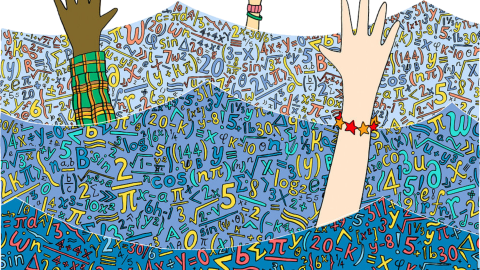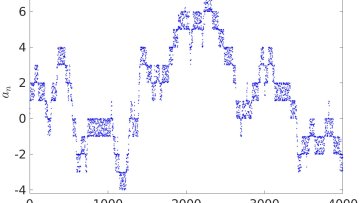16:00
Generalising Mirzakhani’s curve counting result
Abstract
On any hyperbolic surface, the number of curves of length at most L is finite. However, it is not immediately clear how quickly this number grows with L. We will discuss Mirzakhani’s breakthrough result regarding the asymptotic behaviour of this number, along with recent efforts to generalise her result using currents.
15:45
The complexity of knot genus problem in 3-manifolds
Abstract
The genus of a knot in a 3-manifold is defined to be the minimum genus of a compact, orientable surface bounding that knot, if such a surface exists. We consider the computational complexity of determining knot genus. Such problems have been studied by several mathematicians; among them are the works of Hass--Lagarias--Pippenger, Agol--Hass--Thurston, Agol and Lackenby. For a fixed 3-manifold the knot genus problem asks, given a knot K and an integer g, whether the genus of K is equal to g. In joint work with Lackenby, we prove that for any fixed, compact, orientable 3-manifold, the knot genus problem lies inNP, answering a question of Agol--Hass--Thurston from 2002. Previously this was known for rational homology 3-spheres by the work of Lackenby.
The combined modelling of tumour growth and its environment
Abstract
Numerous mathematical models have been proposed for modelling cancerous tumour invasion (Gatenby and Gawlinski 1996), angiogenesis (Owen et al 2008), growth kinetics (Wang et al 2009), response to irradiation (Gao et al 2013) and metastasis (Qiam and Akcay 2018). In this study, we attempt to model the qualitative behavior of growth, invasion, angiogenesis and fragmentation of tumours at the tissue level in an explicitly spatial and continuous manner in two dimensions. We simulate the effectiveness of radiation therapy on a growing tumour in comparison with immunotherapy and propose a novel framework based on vector fields for modelling the impact of interstitial flow on tumour morphology. The results of this model demonstrate the effectiveness of employing a system of partial differential equations along with vector fields for simulating tumour fragmentation and that immunotherapy, when applicable, is substantially more effective than radiation therapy.
16:00
Limit Groups and Real Trees
Abstract
Limit groups are a powerful tool in the study of free and hyperbolic groups (and even broader classes of groups). I will define limit groups in various ways: algebraic, logical and topological, and draw connections between the different definitions. We will also see how one can equip a limit group with an action on a real tree, and analyze this action using the Rips machine, a generalization of Bass-Serre theory to real trees. As a conclusion, we will obtain that hyperbolic groups whose outer automorphism group is infinite, split non-trivially as graphs of groups.
The Power of Analogy in Physics: From Faraday Waves to Quasicrystals
Abstract
Abstract:
Quasicrystals have been observed recently in soft condensed mater, providing new insight into the ongoing quest to understand their formation and thermodynamic stability. I shall explain the stability of certain soft-matter quasicrystals, using surprisingly simple classical field theories, by making an analogy to Faraday waves. This will provide a recipe for designing pair potentials that yield crystals with (almost) any given symmetry.
02:00
Introduction to scrolls
Abstract
Scrolls play a central role in the construction of varieties; they are ambient spaces for K3 surfaces and Fano 3-folds. In this talk, I will say in two ways what scrolls are and give examples of some embedded varieties in them.
16:00
Automorphisms of free groups and train tracks
Abstract
Let phi be an outer automorphism of a free group. A topological representative of phi is a marked graph G along with a homotopy equivalence f: G → G which induces the outer automorphism phi on the fundamental group of G. For any given outer automorphism, the choice of topological representative is far from unique. Handel and Bestvina showed that sufficiently nice automorphisms admit a special type of topological representative called a train track map, whose dynamics can be well understood.
In this talk I will outline the definition and motivation for train tracks, and give a sketch of Handel and Bestvina’s algorithm for finding them.
Adaptive biological networks
Abstract
Can spatial fungal networks be informative for both ecology and network science?
Filamentous organisms grow as adaptive biological spatial networks. These networks are in a continuous balance of two main forces: exploration of the habitat to acquire scarce resources, and the transport of those resources within the developing network. In addition, the construction of the network has to be kept a low cost while taking into account the risk of damage by predation. Such network optimization is not unique to biological systems, but is relevant to transport networks across many domains. Thus, this collaborative project between FU-Berlin and University of Oxford represents the beginning of a research program that aims at: First, setting up protocols for the use of network analysis to characterize spatial networks formed by both macroscopic and microscopic filamentous organisms (e.g. Fungi), and determining the fitness and ecological consequences of different structure of the networks. Second, extracting biologically-inspired algorithms that lead to optimized network formation in fungi and discuss their utility in other network domains. This information is critical to demonstrate that we have a viable and scalable pipeline for the measurement of such properties as well provide preliminary evidence of the usefulness of studying network properties of fungi.



